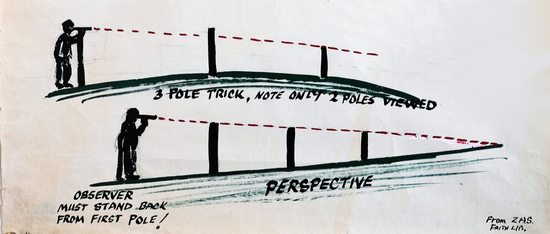Difference between revisions of "John Hampden"
Tom Bishop (talk | contribs) |
Tom Bishop (talk | contribs) |
||
| Line 27: | Line 27: | ||
The experiment involved aligning three poles of equal height. If the middle pole was elevated it would be evidence that the Earth was a globe. If the poles aligned it would be evidence that the Earth was flat. | The experiment involved aligning three poles of equal height. If the middle pole was elevated it would be evidence that the Earth was a globe. If the poles aligned it would be evidence that the Earth was flat. | ||
| − | Objections to the methodology of the experiment revolved around the nature of perspective and improper execution. In execution of the experiment the observer was standing at the location first pole looking over it at the other two poles. The observer is only observing two poles, invalidating the experiment. For example, a ten foot tall tree at 50 feet away would look larger and taller than a ten foot tall tree at 100 feet away. Therefore if only two poles are viewed the nearest one will be taller than the furthest one. | + | Objections to the methodology of the experiment by William Carpenter revolved around the nature of perspective and improper execution. In execution of the experiment the observer was standing at the location first pole looking over it at the other two poles. The observer is only observing two poles, invalidating the experiment. For example, a ten foot tall tree at 50 feet away would look larger and taller than a ten foot tall tree at 100 feet away. Therefore if only two poles are viewed the nearest one will be taller than the furthest one. |
| − | + | Samuel Shenton later illustrated the fallacy in his lecture posters: | |
[[File:Three-pole-trick.png|550px]] | [[File:Three-pole-trick.png|550px]] | ||
Revision as of 07:30, 1 January 2022
John Hampden (1819-1891) was an English scientist of the Royal Academy. He believed in Flat Earth Theory and performed the Bedford Level Experiment several times, most notably as a part of his wager with Alfred Russel Wallace. He vigorously promoted the flat earth idea in England. He founded the Truth-Seeker's Oracle and Scriptural Science Review in 1876. Hampden was a Biblical literalist and based his views on scripture (No one can believe a single doctrine or dogma of modern astronomy, and accept Scriptures as divine revelation.) although he defended them through observation and experiment.
Early Life
Hampden was born to John and Margaretia Hampden in 1819. Not much is known about his childhood apart from the fact that he took great interest in both science and religion.
Wager with Wallace
|
In 1870, John Hampden offered £500 to anyone who could prove that the Earth was round by repeating the Bedford Level Experiment. Alfred Russel Wallace, needing money, accepted the offer and the two went to the Bedford Level to perform Rowbotham's experiment.
Although Wallace has been awarded the bet by the referee, John Henry Walsh, an editor of The Field sports magazine, Hampden took an issue with the execution of the experiment, which deviated from Rowbotham's description, and rejected his demonstration. Despite his objections, the money was awarded to Wallace. Hampden then produced a pamphlet titled Is Water Level Or Convex After All? The Bedford Canal Swindle Detected & Exposed, accusing Wallace of cheating.[1]
He then sued A. R. Wallace, claiming the bet to be invalid, and issued multiple postcards demanding the return of his money as well as accusing him of being a cheat, a swindler, an impostor, and a thief (among other things). His persistence caused Wallace to sue Hampden for libel. After many long court battles the bet was deemed to be invalid and Hampden's money was returned to him in full. However, throughout the resolution of the conflict, Hampden had to pay multiple libel suits to Wallace, issue two apologies and was ultimately imprisoned for his remarks.
The court case, together with some of Hampden's libelous remarks, was described in The Times in March 1875:
The Hampden-Wallace conflict greatly popularised the Bedford Level Experiment, giving it media attention and encouraging some individuals to reproduce it.
Three Pole Trick
The experiment involved aligning three poles of equal height. If the middle pole was elevated it would be evidence that the Earth was a globe. If the poles aligned it would be evidence that the Earth was flat.
Objections to the methodology of the experiment by William Carpenter revolved around the nature of perspective and improper execution. In execution of the experiment the observer was standing at the location first pole looking over it at the other two poles. The observer is only observing two poles, invalidating the experiment. For example, a ten foot tall tree at 50 feet away would look larger and taller than a ten foot tall tree at 100 feet away. Therefore if only two poles are viewed the nearest one will be taller than the furthest one.
Samuel Shenton later illustrated the fallacy in his lecture posters:
References
- ↑ Hampden, John (1870): The Bedford Canal swindle detected & exposed. A. Bull, London.


